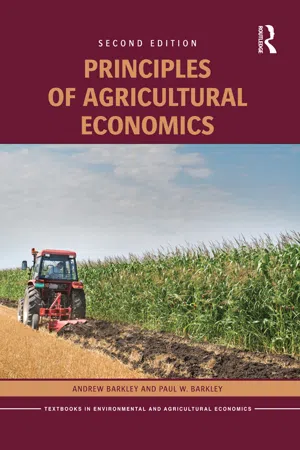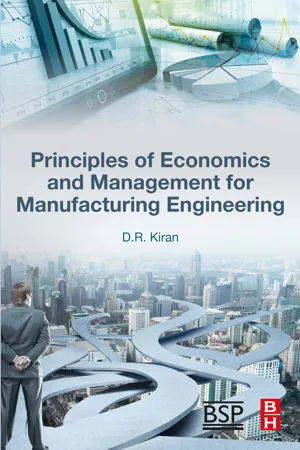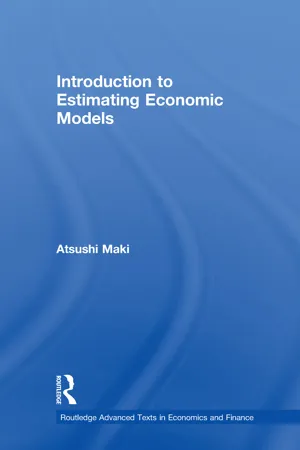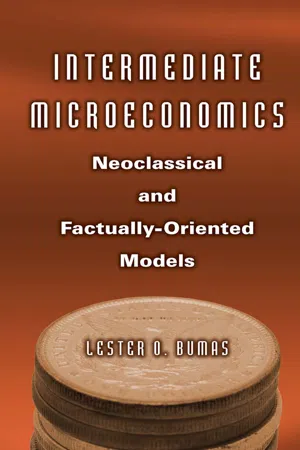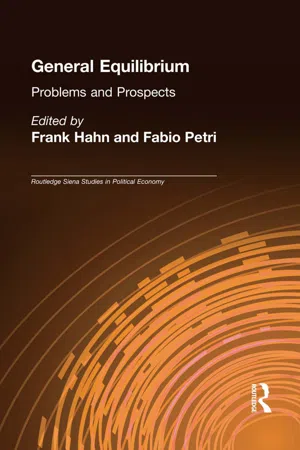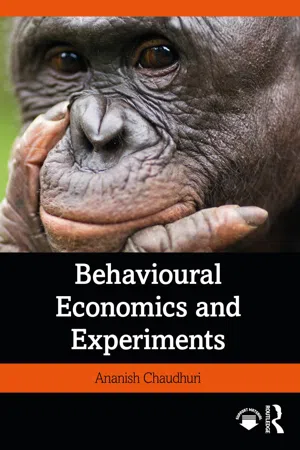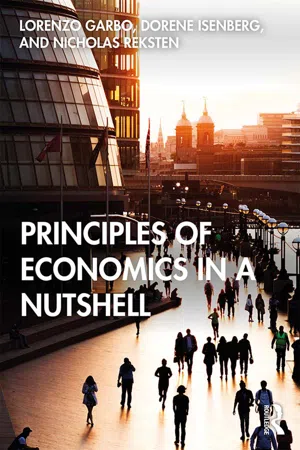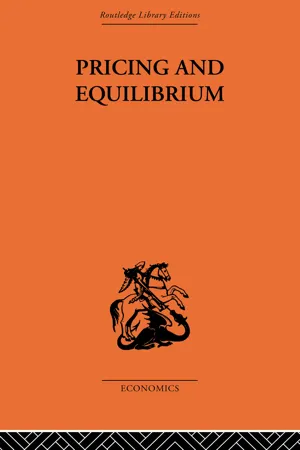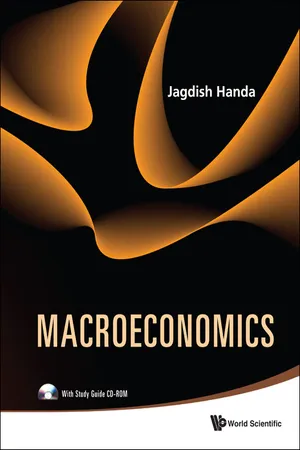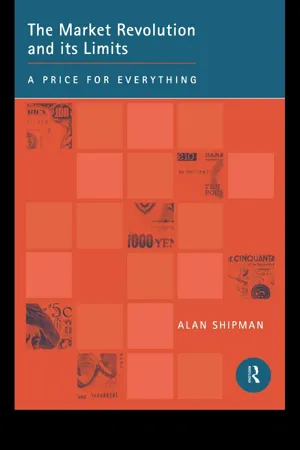Economics
Market Disequilibrium
Market disequilibrium refers to a situation where the quantity of a good or service supplied does not equal the quantity demanded at the prevailing market price. This imbalance leads to shortages or surpluses, causing market inefficiencies. Disequilibrium can occur due to shifts in supply or demand, price controls, or external shocks, and often requires market adjustments to restore equilibrium.
Written by Perlego with AI-assistance
Related key terms
12 Key excerpts on "Market Disequilibrium"
- eBook - ePub
- Andrew Barkley, Paul W. Barkley(Authors)
- 2016(Publication Date)
- Routledge(Publisher)
This procedure also helps calculate a below-equilibrium price that leads to a shortage. Suppose that the price of wheat drops to USD 2/bu. The inverse supply and inverse demand equations yield the following estimates of quantities:(10.11.a) 2 = 1 + 0.1Qs(10.11.b) 1 = 0.1Qs(10.11.c) Qs = 10 million bushels of wheat,(10.11.d) 2 = 5 – 0.1Qd(10.11.e) 3 = 0.1Qd(10.11.f) Qd = 30 million bushels of wheat.The shortage quantity (Qd – Qs ) can also be calculated:(10.12) Shortage = (Qd – Qs ) = 30 – 10 = 20 million bushels of wheat.This procedure also helps calculate changes in supply or demand brought about by economic variables. Chapters 11 –13 will provide additional information related to markets. They will show how outcomes depend on government policies, and the number of firms in a market, or market structure.10.5 Summary
- A market is an institution where buyers and sellers interact. A marketplace is a physical location where buyers and sellers meet to exchange goods.
- The interaction between buyers and sellers determines the price of a good and the quantity of the good purchased and sold.
- Market equilibrium is the point where the quantity supplied at a given price is equal to the quantity demanded. The equilibrium price is the price at which quantity supplied equals quantity demanded. The equilibrium quantity is the point where quantity supplied equals quantity demanded.
- Disequilibrium is a market situation in which the market price does not equate supply and demand.
- Economic forces will result in the price always gravitating toward the equilibrium price.
- A surplus is a market situation where quantity supplied is greater than quantity demanded.
- A shortage is a market situation where quantity demanded is greater than quantity supplied.
- The inverse supply function is represented by a price as a function of quantity supplied. The inverse demand function is represented by a price as a function of quantity demanded.
- D.R. Kiran(Author)
- 2022(Publication Date)
- Butterworth-Heinemann(Publisher)
5.1 clarifies the combined effect of these two laws on the prices. As the price increases, the demand from the customer’s side would reduce, but the producers would be motivated to produce more and supply more to get higher income. In a competitive market, such a situation would stabilize the price and the supply would be same as the demand, as shown by X in Fig. 5.2. Fig. 5.2 Equilibrium price. At the point of intersection, X, there is neither a shortage of demand nor an excess of supply. The market price at which demand equals supply is called the equilibrium price. In other words, at equilibrium price, the price is such that buyers are willing to buy and the sellers are willing to sell exactly the same quantity; the price will ultimately settle down at this equilibrium price. 5.7: Temporary equilibrium price Sometimes, in a competitive market, due to the varying excessive or short supply situation, the price will be so adjusted, through the competition of buyers and sellers, that the quantity demanded will be equal to the quantity offered at that price, which is known as the temporary equilibrium price or the moving equilibrium price. This is like the intercontinental ballistic missile (ICBM), which keeps adjusting its direction in a ballistic manner. The share market prices can provide the best illustration for this effect. Example Suppose, for instance, the market is not in equilibrium, as in the case when the price is higher, say, Rs 3 per kg, then producers are unable to sell some of their stocks and begin to offer their goods at lower prices. Consumers, on their part, noticing the glut, begin to offer lower prices. Due to either or both of these reasons, the market price will fall. The reverse tendency exists for all prices below the equilibrium price. When the price is, say, Rs.1/- per kg, the consumers may begin to offer higher prices, since there is a shortage of supply, and are unable to fulfill their requirements- eBook - ePub
- Atsushi Maki(Author)
- 2010(Publication Date)
- Routledge(Publisher)
4 Market equilibrium models
Market analysis in economics is typically informed by the idea of market equilibrium. We define market equilibrium as the point where transactions occur that are satisfactory to both consumers and producers – satisfactory in the sense that consumers are willing to pay a price at which producers are willing to supply a particular good or service.In constructing a competitive-market equilibrium model, we specify the market demand and market supply functions in order to determine the equilibrium point numerically. In the goods and services market, the market demand function is obtained as a result of utility maximization by households, and the market supply function is obtained as a result of profit maximization by firms.We establish different market equilibrium conditions for competitive, oligopolistic, and monopolistic markets so that we can a priori decide the market characteristics that we will focus on when analyzing a particular market. In a competitive market, market equilibrium is indicated at the intersection of the market demand and market supply curves. In a monopolistic market, quantity and price are not determined by the intersection of the market demand and market supply curves. Rather, under monopoly conditions, the equilibrium quantity is less than that in a competitive market and the equilibrium price is higher. The equilibrium condition for suppliers is not p = MC (market price = marginal cost) but MR = MC (marginal revenue = marginal cost), satisfying the profit maximization condition for the firm. In a monopolistic market, when demand is inelastic, it is possible that equilibrium does not exist.When estimating a model in a competitive market, a simultaneous-equations model is necessary because the model includes demand, supply, and other equations. Therefore, the identification problem - eBook - ePub
Intermediate Microeconomics
Neoclassical and Factually-oriented Models
- Lester O. Bumas(Author)
- 2015(Publication Date)
- Routledge(Publisher)
Y . The market for blue-chip stocks and bonds, however, is virtually worldwide. They are sold in many countries. Moreover, were they any cheaper in Tokyo, London, or Frankfurt, than in New York, there would be a tendency to buy the stocks at the cheaper stock exchange. The implied increase in demand at the lower-priced market drives price up; as the decreased demand at the higher-priced market drives price down. Thus, the tendency is toward one price.Equilibrium and Its Attainment
Our concern here is with how the market equilibrates the supply and demand price and the quantity demanded and supplied. There are two approaches to the attainment of equilibrium. One is that of Leon Walras; the other the creation of Alfred Marshall. Textbooks generally utilize a simplified version of Walras’s model, which is presented first. Marshall’s takes second place. The examples used by both Walras and Marshall involved commodities exchanged in auction markets.Walras’s Model
In Figure 3.1 can be found hypothetical market supply and demand functions. The product in question is wheat. The demand function is shown as negative-sloped, a manifestation of the income and substitution effects. The supply function is shown as positive-sloped in keeping with the law of diminishing marginal returns or marginal productivity.Figure 3.1. Equilibrium via the Response of Price to Quantity DisequilibriaAssume, that at the start of the trading day the price of wheat isPHI. At that price the quantity supplied exceeds the quantity demanded yielding the surplus shown. That surplus causes the price to be bid down until the quantity supplied equals that demanded. At that quantity equilibrium, the market-clearing or equilibrium price,PEQ, would occur.Equilibrium - eBook - ePub
General Equilibrium
Problems and Prospects
- Frank Hahn, Fabio Petri(Authors)
- 2003(Publication Date)
- Routledge(Publisher)
The second mistake is the belief that such problems can be avoided by redefinition of terms so that there is no such thing as disequilibrium. For example, the non-clearing of markets by prices is sometimes said not to be an example of disequilibrium because agents form queues, with the length of the queue being determined by the shadow price of time as well as by money prices. This may be a valuable way to think about what happens when markets fail to clear, but it reformulates rather than solve that question (What happens to money prices? How do the queues themselves disappear over time?). Certainly, there is a sense in which the disequilibrium behavior of any given system can be represented as the equilibrium behavior of a larger system in which the original one is embedded. To say this, however, is only to say that there is some definite outcome out-of-equilibrium in the smaller system. To insist that therefore there is no such thing as disequilibrium is to rob the term “equilibrium” and all equilibrium analysis of meaning. For if “equilibrium” is to be a useful concept in analyzing a particular system, then one must contemplate the possibility of points that are not equilibria of that system. The fact that such points can be represented as equilibria in some larger system does not change this.If equilibrium analysis is to be justified, the crucial question that must first be answered is one of stability. That question in its most interesting and general form is as follows. Suppose an economy is made up of agents who understand that they are in disequilibrium and perceive and act on profit opportunities. Does the action of those agents lead the economy to converge to equilibrium, and, if so, to what sort of equilibrium? I shall refer to this as the “key question” of stability analysis.It is important to note, however, that while stability of competitive general equilibrium is perhaps the only disequilibrium question addressed in a long literature, that literature has seldom addressed the key question directly. Rather, as we shall see, writings on the stability of general equilibrium have only recently endowed agents with much perception. Instead, agents have been supposed to make their plans as though disequilibrium did not exist, and the interaction of those plans has been modeled only as an afterthought at best. - eBook - ePub
- Ananish Chaudhuri(Author)
- 2021(Publication Date)
- Routledge(Publisher)
14 Behavioural analyses of markets In this chapter, I:- Provide an overview of the workings of the market system, including the concepts of demand, supply, equilibrium price, consumer surplus and producer surplus;
- Show that markets may take various different forms with differing rules and institutions;
- Explore the implications of different market structures for the prices that prevail in those markets and for consumer and producer surplus;
- Revisit the role of fairness in determining market outcomes;
- Examine the role of price controls within these market institutions.
Introduction
I started working on this book in the early part of 2020 when the world was going through the COVID-19 pandemic. Within a matter of months, if not weeks, the Dow Jones Index (and others such as S&P 500) tumbled as share prices fell with panicked investors selling off shares that they expected to lose value. As international travel came to a standstill, demand for airline tickets fell and so did prices as airline companies started offering deals to attract flyers. With tourism non-existent, the price of hotel rooms fell and, with more and more people not driving during stringent lockdowns, the demand for fuel fell, leading to a sharp drop in petrol prices. By May of 2020, nearly 40 million people had filed for unemployment in the US as businesses stopped hiring. Almost everyone has an intuitive understanding of why these things happened. They are all attributable to the workings of the market system via demand and supply. Since businesses were not hiring, the supply of workers (or labour) far exceeded the demand, leading to large scale unemployment. As people drove less, there was less demand for petrol, leading to a fall in price. Most investors wanted to sell off their shares with few willing to buy, leading to a steep fall in the price of shares.Demand and supply are two frequently used words in economics. In fact, most people think that demand and supply constitute the bulk of economics. The next time you are at a social gathering and you tell people that you are studying economics, sooner or later, someone will say something along the lines of: “It’s all demand and supply, right?” At this point, you will also realize that this is partly, but not entirely, correct. After all, we are in Chapter 14 - eBook - ePub
An Introduction to Economics
Concepts for Students of Agriculture and the Rural Sector
- Berkeley Hill(Author)
- 2021(Publication Date)
- CAB International(Publisher)
3 Demand and Supply: the Price Mechanism in a Market EconomyIntroductionThe study of the demand and supply of goods and services, and the way they interact, forms a fundamental part of economics. Indeed, a surprisingly high proportion of economic problems we come across in everyday life can be explained, although perhaps not solved, by a careful examination of the demand and supply of goods or services. It has even been suggested that a parrot could be turned into a passable economist simply by teaching it to say the words ‘demand and supply’ in reply to all questions.By way of introduction to this important area of study let us take an example from agriculture. At various times of the year some farmers want to buy barley while others are willing to sell barley – a demand and a supply both exist. Transactions occur at markets where buyers and sellers can meet each other. These used to be physical places but nowadays this could equally well be Internet websites. Let us imagine that we can select one market on one day (say, in early December) and have the power to ask as many questions as we like. Furthermore, let us imagine that we can dictate what the price of barley is to be.If we take all those who wish to buy barley and tell them that the price will be £100/t on that day – assume this is a high price for the particular season – very few farmers will wish to buy any and the quantity sold will be small. If we say that the price will be £90/t, more buyers will be interested. As the price is lowered, increasing interest will be shown – more farmers will wish to buy and each will tend to buy more. If we make a table of the quantity of barley we could sell at various prices we end up with a demand schedule .If we moved on to suppliers of barley we would find that at a low price the quantity which they would be prepared to sell would be small. But if we offered a higher figure the quantities offered would increase – more sellers would want to sell and each would want to sell a greater quantity. Again we could draw up a table or schedule of prices and quantities of barley which suppliers would be prepared to supply at these prices. - eBook - ePub
- Lorenzo Garbo, Dorene Isenberg, Nicholas Reksten(Authors)
- 2020(Publication Date)
- Routledge(Publisher)
In the bazaar or the souk this is all typically done loudly and in the open, not something we see very often, but it is a great example of how all markets actually work, even though they do this less visibly. The function of the market is to make transactions possible, by determining a price at which buyers and sellers are willing to buy and sell the same amount of the good or service in question. Another way to say this is that, in general, a market for a good or service identifies the equilibrium price at which the quantity of that specific good/service demanded by consumers becomes equal to the quantity supplied by sellers. This equilibrium price, of course, depends on the relative strength of the demand and the supply of the good/service. Typically, the relative strength of demand and supply, and thus the corresponding equilibrium price, keep changing through time. An example of the dynamic nature of equilibrium prices, perhaps familiar to those who happen to get news updates during the business hours of the New York Stock Exchange, is given by the large number of stock prices which tend to change many times per minute. A simpler, slower, and more detailed example of the dynamic nature of an equilibrium price in response to changes in demand and supply is provided by the shifts undergone by the U.S. market of corn about 10 years ago (data from the USDA’s National Agriculture Statistical Service 1): in 2005 the price of corn in the US market was $2.60/bushel; during 2005, high oil prices and instability in the Middle East produced incentives to get corn-based ethanol as a fuel substitute for gasoline; new ethanol plants began purchasing more corn. The demand for corn increased, creating a shortage (larger quantity demanded than supplied) of corn. Consumers of corn began to bid against each other to obtain corn, making the price of corn increase - eBook - ePub
- Erich Schneider(Author)
- 2013(Publication Date)
- Routledge(Publisher)
This price is then the equilibrium price for the coming week which would be forthcoming in an organized market, and calculated by the broker from the orders of buyers and sellers. Of course, as we have already emphasized, not very much is discovered simply by ascertaining the existence of an equilibrium price. We have to know (a) whether the equilibrium price is stable or not, (b) how the equilibrium price varies with a change in the data. The problem of stability will be dealt with in the same way as in para. 1, so that we can refrain from discussing it further. Let us confine ourselves to the second problem: the influence of a change in data on the equilibrium position. This problem also has already been discussed in para 1. We showed by a comparative-static analysis how changes in the quantity supplied per unit of time influenced the equilibrium price, if the demand curve remained unchanged. We now wish to apply such a comparative-static analysis in our present example. Changes in data obviously express themselves either through changes in the demand curve and/or in the supply curve. If the demand curve shifts from one period to another, that means that at each price a larger or smaller quantity will be demanded than in the previous period, so that we may say that demand has increased (or diminished). An increase in demand will be represented in our diagram by a shift of the demand curve to the right, and a decrease in demand by a shift to the left. In the same way we may speak of an increase (or decrease) in supply from one period to the next if at every price a greater (or smaller) quantity is supplied than in the previous period. An increase (or decrease) of supply will then be represented geometrically by a shift in the supply curve to the right (or left). Shifts in the demand curve can occur as a result of changes in tastes, or in the prices of other goods, or in the distribution of income - Robert Marks(Author)
- 2017(Publication Date)
- Routledge(Publisher)
CHAPTER IV: PRICE ADJUSTMENTS IN THE DISEQUILIBRIUM MODEL4.1. Price determination.Note that the previous discussion has implicitly assumed Jevon's Law of Indifference: that there is only one price in a competitive market. But, as Arrow (1959) remarks, there is no reason for profit- or utility-maximizing behaviour on the part of both sides of the market to lead to a unique price except in equilibrium or under conditions of perfect knowledge. In the situation where demand exceeds supply in the market for output, that is, when the representative firm (supplier of output) is on the short side of the market, then the firm can be thought of as a monopolist if each individual entrepreneur believes that raising his price will increase his profit. The process of adjustment, when each is attempting to raise his price, involves much uncertainty, and although there will be a broad tendency for prices to rise when demand exceeds supply, there can easily be considerable dispersion of prices among different sellers of the same good, and considerable variability over time in the rate of price change. Arrow characterizes the disequilibrium situation as a number of monopolists facing a number of monopsonists, and remarks on the value of information in consequence: entrepreneurs need to know the whole of the demand curve, not merely the current price.Thus, in assuming a single price and (implicitly) perfect knowledge of the aggregate supply and demand on the part of individual buyers and sellers, this paper is not modelling Arrow's disequilibrium adjustment process. Rather, the process described in the preceding pages can be thought of as resulting from the existence of an auctioneer who calls a price, notes the resulting offers to buy and sell, and then announces the gross aggregate demand and supply at the price, after which trading will occur neither with market clearing nor with the possibility of recontracting. A Walrasian auctioneer would not be so passive—he would alter the price in an attempt to reduce the difference between aggregate supply and demand, and either no transactions would occur until a marketclearing price had been determined, or such transactions as did occur beforehand would be recontractable after the market-clearing price had been determined. If the process Arrow describes is more realistic than ours, ours in turn is more realistic than that of the Walrasian tatonnement, and, moreover, with the addition below of finite rates of price adjustment, our formulation admits of the possibility, with reasonably simple analysis, of stable quasi-equilibria with price-inflation or -deflation and unemployment and demand-constrained recessions.- eBook - ePub
Macroeconomics
(With Study Guide CD-ROM)
- Jagdish Handa(Author)
- 2010(Publication Date)
- WSPC(Publisher)
Alternately, observing some (though relatively slow) movement in the economy, we can say that the situation is one of disequilibrium; though the economy’s inherent forces or mechanisms are weak, they will eventually get the economy to full employment. These are two different ways of describing a slowly adjusting economy, analogous to describing a glass as being ‘half full’ or ‘half empty’. How long is ‘eventually’ in real time? In practical terms, leaving aside semantics and dogma, an economy in such a disequilibrium situation might spend several quarters or even years below full-employment output. 16 In such situations, policy could play a very useful role in speeding up the return to full-employment equilibrium. Impact of the disequilibrium on the long run: hysteresis Can the dynamic path during disequilibrium affect the short-run and long-run equilibrium positions for the future? This would occur if it alters the accumulation of skills and physical capital while the economy is away from equilibrium. Less of these are accumulated in recessions than in booms, so that drawn-out recessions and booms can leave their impact on the economy beyond their own duration. Such an effect of the short-run adjustment on the long-run path is called hysteresis. Mild recessions and booms would not have a significant hysteresis effect, while long and deep recessions and strong booms are likely to leave behind their impact on the long-run of the economy. 9.8 Optimal Monetary and Fiscal Policies for the Demand-Deficient Economy The policy cure for an economy suffering from the hangover of a demand deficiency requires a policy-induced expansion in aggregate demand - eBook - ePub
The Market Revolution and its Limits
A Price for Everything
- Alan Shipman(Author)
- 2002(Publication Date)
- Routledge(Publisher)
Clower’s analysis confirms Keynes’s (1936) intuition that with aggregate expenditure a fixed fraction of aggregate income (the consumption function), the circular flow of income is likely to be brought into balance by changes in aggregate output rather than changes in relative prices. A fall in expenditure, caused either by lower income (due to false trading) or a rise in the savings rate, leads to a fall in aggregate output, and workers become unemployed without any necessity for their wage to be above their marginal productivity. Subsequent analyses of trading at non-equilibrium prices have confirmed that constraints on the quantities that agents can sell may lead to a settled pattern of trading activity in which aggregate demand falls short of aggregate supply. ‘Disequilibrium analysis…generalises the traditional theories of demand, supply and price formation to cases where, in the absence of an auctioneer, markets do not automatically clear’ (Benassy 1989:127).Such aggregate demand failure can be prevented by detaching current consumption from current income and linking it instead to ‘permanent’ income (Friedman 1957), the agent’s assessment of its long-run budget constraint which is assumed to be that which emerges from continuously maintained general equilibrium. Any short-run demand constraint is recognised as temporary, and prevented from transmitting through the system because agents maintain their previous level of consumption, even if this temporarily moves above their current income. The tendency for outputs to adjust instead of relative prices now looks once again like price rigidity, resulting from labour or capital market imperfection. But this again presupposes that agents’ perception of permanent income is consistent with the income they receive in intertemporal equilibrium, and that they have the resources to override a current income constraint.
Index pages curate the most relevant extracts from our library of academic textbooks. They’ve been created using an in-house natural language model (NLM), each adding context and meaning to key research topics.
